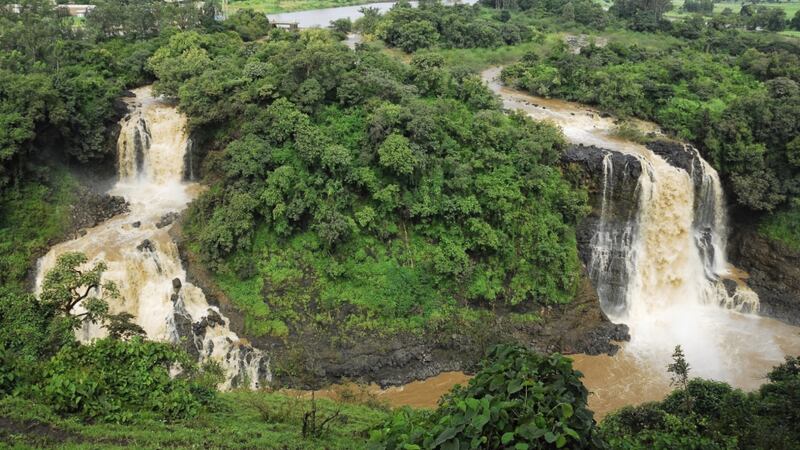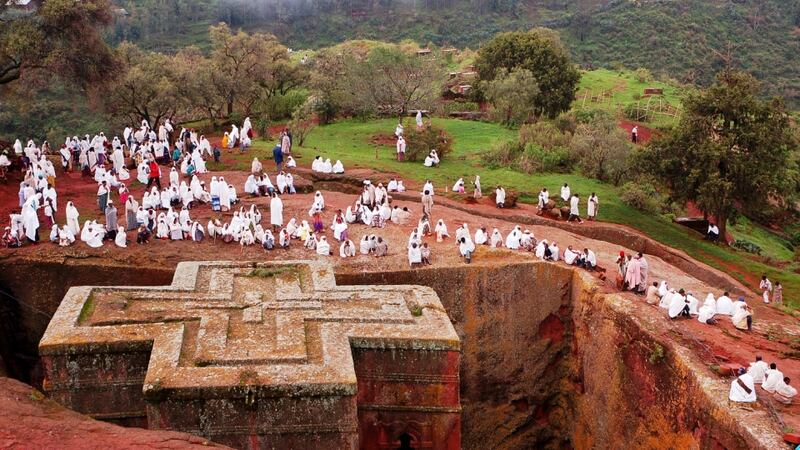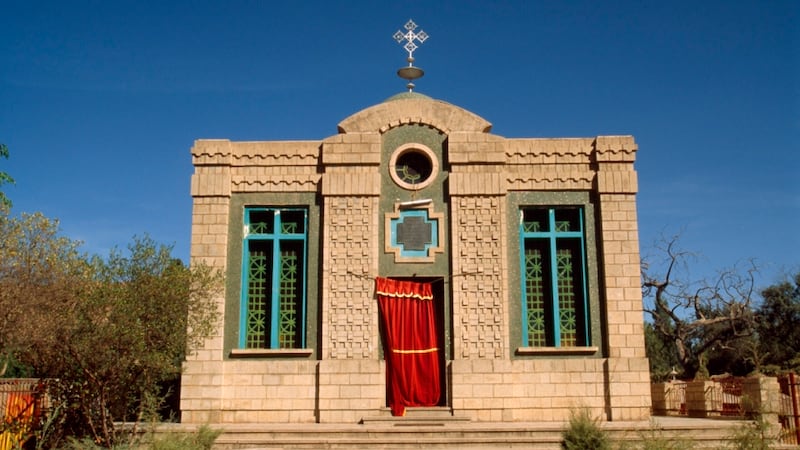ETHIOPIA HAS LEFT me utterly selfish. After a week in this spectacular country I have been consumed by it and want to keep it all to myself. I don’t really want to see tourists scrambling to take photographs in the ancient churches and palaces I have been introduced to. I don’t want others to come and see the beauty of its people or the anger of its storms, to experience the silence of its forests and lakes or to feel the elegance of its music and dance. But everyone should. This is Africa as it is imagined, and it defies all expectations.
Yes, our existing images of Ethiopia are harrowing, but those images created an emotional attachment to Ethiopia that shouldn’t be ignored. Before my trip I told everyone I met where I was going, just to gauge their reaction. While most were surprised, they were also excited by the idea and wanted to know more. It seems people want to like Ethiopia. They feel they know it and have an interest in its future.
Religion is everywhere in Ethiopia. In fact, for anyone brought up with even a vaguely Christian education, a trip to Ethiopia is your catechism brought to life. The traditions and way of life outside the cities, particularly surrounding its historic sites, can only be described as biblical. It sounds an overly dramatic description, but this is a place where time has stood still. At least for now.
0 of 4

Three-quarters of the country’s 70 million people work in agriculture. In truth, they eke a living from land that would, for much of the year, make Irish farmers weep. There are no machines or tractors to be seen, and farmers urge oxen to pull wooden ploughs through dry soil.
Apart from a brief period of occupation by Mussolini’s Italy in 1935-41, Ethiopia managed to defy the wave of colonisation that swept across Africa from the 19th century. Its neighbours in the horn of Africa – Sudan, Somalia, Eritrea, Djibouti and Kenya – all fell to European invaders. This isn’t just a blip on its timeline; it reflects Ethiopia’s power and influence at the time and allows a visitor today to revel in a country that is wholeheartedly itself, free of European imposition, architecture or ideology. It’s a country as large as France and Spain combined and as diverse in wildlife, habitats and landscape as the European continent, and it’s incredibly beautiful. There’s also a tangible pride. Ethiopians know who they are. And we should, too.
Ethiopia is said to be the cradle of civilisation and the probable origin of human life (see below). The capital, Addis Ababa, is one of the most developed in Africa. The African Union, Africa’s equivalent of our Brussels-based European Commission, is located there, as are many international NGOs and other organisations.
And in our caffeine-driven world it is reassuring to know that it is also the origin of coffee. You are guaranteed strong black coffee anywhere in Ethiopia, and the ceremony of grinding, roasting and preparing the beverage remains as central to life as the espresso is to Italy.
In fact Ethiopian cuisine is extremely good. Food comes on communal platters and is a selection of highly spiced and flavoured meats and vegetables. You use the grey flat bread that accompanies it, which has an odd fermented taste, to scoop up the food in place of cutlery. It’s a very sociable experience, as is much of what tourists will experience there, whether in bars, restaurants or hotels.
Indeed, hotel standards are rising fast. In Addis you will find international chains such as Hilton and Sheraton. For anyone going on a trip similar to mine, these international chains should feature on your first and last nights, for a sense of luxury because outside the cities the hotels are mostly tourist class.
Mind you, it seems anything is possible in Ethiopia; the company organising our trip was getting ready to meet a group of South African millionaires, who were to be escorted around the country by helicopter.
Tourism is so new to this country that in some areas the attention of the locals is unnerving. Children flock around tour buses, and people try to sell you goods. But it isn’t yet as overbearing an experience as in Egypt or India, and our guides suggested it would be better for everyone if we gave to a local charity or school, or bought extra gifts in the markets, instead of giving money to the children who came to meet us. They didn’t want tourism to turn Ethiopia into a country of beggars, they explained. It’s a sign that tourism, at least for some, has a conscience there.
Building a tourism industry from scratch is never easy. There are many ethical issues and other challenges to doing it right, but a tourist euro spent properly can go very far indeed – perhaps farther than one that arrives via western aid. And in return you get to visit one of the oldest, most cultured and beautiful countries there are.
What you should know about Ethiopia’s past, and when to visit
Cradle of civilisation?
It is widely accepted among theorists of evolution that humans originated in the Horn of Africa, and much evidence places Ethiopia as one of the most likely regions where human life began. This is quite a claim to fame – and one that should be better known.
The national museum in Addis Ababa tells the story as best it can, but it is currently without its most central character, Lucy, who has been sent on a tour of US museums. Lucy is a three-million-year-old skeleton found in 1974 by European and US scientists. The name came from the Beatles song Lucy in the Sky with Diamonds, said to have been playing in the camp the night the skeleton was discovered. (Her Ethiopian name is Dinkenesh, which means You Are Beautiful.)
The quality of her remains and the fact that her pelvis and leg bones are almost identical in function to modern humans’ puts her centre stage in evolutionary theory, even though even older remains have since been found.
Lucy is to return home this year, to take her rightful place in a new national museum being built in the capital.
Lalibela

Lalibela, which easily dominates the historic route in Ethiopia, is one of the country’s holiest places. In the 12th and 13th centuries 11 churches were hewn from rock and earth; they stand below ground, with only their rooftops visible at ground level. The best known is Bete Giyorgis, or St George, church. With some connected by tunnels and others standing in isolation, they cannot fail to capture the imagination. As their story unfolds, so does the story of Ethiopia. Each of the churches contains magnificent art and religious iconography; they are central to religious life in the region. They are now a World Heritage site.
Aksum

It’s not often you come so close to biblical landmarks, but the Mary Zion church in the historical town of Aksum holds one of the most important: the Ark of the Covenant.
Housed in the grounds of two larger churches, the Mary Zion church is perhaps one of the most mysterious and deeply respected places of pilgrimage in the country. It is believed that the Ark of the Covenant holds the stone tablets given to Moses on Mount Sinai and on which are inscribed the Ten Commandments.
No one has ever set eyes on the ark; it is is believed that to try will bring death – a threat that failed to stop a European tourist last year from attempting to scale the fence surrounding the church and disclose its secrets to the world. He was quickly stopped, and now tourists are kept at a respectful distance.
Nearby, the Italian government is reinstating a 1,700-year-old 24m obelisk that was taken from Aksum and erected in Rome in 1937. Long recognised as a major cultural theft, it has taken decades of diplomacy to see this symbol of Ethiopian identity returned.
Ethiopian calendar
The country follows the Julian calendar, which consists of 12 months of 30 days each and a 13th month of five or six days. The year begins on September 11th; the Ethiopian year 2002 will begin on our September 11th, 2009 – a great time to visit, as not only will it be the new year but the rainy season will also be finishing, leaving the countryside lush and bursting with life.
When to go
The main rainy season is from mid-June to mid-September, so the ideal time for Irish tourists to take the historic route would be spring or autumn.
Locals spoke with excitement of the weeks and months after the rains, when everything would be in bloom and the hills and mountains would burst with plants and wildlife.
For trips to the national parks in the south of the country, to see big game, the rainy season is slightly different.
For those seeking birdlife any time is the right time, as Ethiopia is home to about 800 species, inhabiting wetlands, highlands, forests and lakes.
Safety
Ethiopia is generally a safe country for travellers, despite the risk of political disturbances and instability in some of the remoter regions not usually visited by tourists, according to the Department of Foreign Affairs. For its full advice see www.dfa.ie.
Go There
Gary Quinn was a guest of Ethiopian Airlines (www.ethiopianairlines.com, ethiopian@premair.ie, 01-6633938), flying via London Heathrow, and Ethiopian Quadrants (www.ethiopianquadrants.com). Its 12-day historic-site tour visits Aksum, Lalibela, Gondar, Bahir Dar and the Simien Mountains. See also www.tourismethiopia.org and www.unesco.org.












